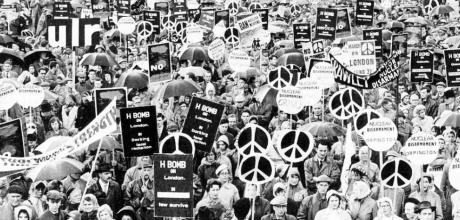CND symbol

The nuclear age demanded an outbreak of peace, and this was the banner behind which campaigners united
Icon WORDS DELWYN MALLETT
As the 1950s drew to a close, there was a widely held fear that the world was teetering on the brink of self-inflicted extinction. The three nuclear powers – USA, USSR and Britain – were engaged in a ‘mine’s bigger than yours’ race and popping off atomic bombs like firecrackers. By 1958 almost 300 bombs had been tested, mainly in the atmosphere. Citizens of a nervous disposition and many children fell asleep at night wondering if they would be alive by morning. A national four-minute warning was introduced in 1953, in which air raid sirens would announce the imminent arrival of an intercontinental missile, giving you time to say cheerio to your chums and dive under the nearest table before being frazzled.
The Campaign for Nuclear Disarmament was formed against this backdrop and held its first public meeting at Westminster’s Methodist Central Hall on 17 February 1958. Meanwhile a tiny pacifist group, the Direct Action Committee Against Nuclear War (DAC), planned a ‘Ban the Bomb’ march for that Easter weekend from London’s Trafalgar Square to the Atomic Weapons Research Establishment at Aldermaston, some 50 miles away, and CND decided to support it.
All good marches need a banner to wave and on 21 February Gerald Holtom, a DAC sympathiser from Twickenham, West London, provided just such a symbol, arguing that it would give their aims greater impact on the general public. Instantly accepted by DAC, the CND also decided to adopt it.
Holtom, born in 1914 (he died in 1985), was a World War Two conscientious objector, a pacifist, a graduate of the Royal College of Art and at the time working for the Ministry of Education. His design, now one of the most recognised and reproduced symbols of the 20th Century, was based on the semaphore flag signalling alphabet, superimposing ‘N’ for nuclear over ‘D’ for disarmament and contained within a circle. The symbol could actually have been the other way up as Holtom favoured the term ‘unilateral disarmament’, which was the aimof DAC, and the semaphore for ‘U’ is flags angled upwards.
With the march barely more than a month away the DAC went into overdrive, producing 500 cardboard placards to be distributed to the marchers. A Guardian reporter covering the event referred to the symbol as ‘a sort of formalised white butterfly’, an impression perhaps created by the fact that half the placards were white on green. The black-and-white version was to be shown on Good Friday and Saturday, the white-on-green on Easter Sunday and the Monday, to reflect the Easter theme of ‘from winter to spring, from death to life’. The arms of the symbol were also chunkier than the current streamlined version, flaring out as they reached the outer circle.
The first CND badges were hand-produced in black on white ceramic and distributed with a leaflet explaining that in the event of a nuclear war they would be among the few human artefacts to survive the inferno. Tin badges followed and within no time very few students were to be seen without a CND badge attached.
As the 1960s progressed, the sign migrated across the Atlantic where it was appropriated by hippies and the emerging counter-culture and morphed into a universal peace symbol, accelerated by student unrest over Vietnam. In 1999 the US Post Office issued a stamp that featured the symbol as a badge attached to the pocket of a denim jacket.
Neither Holtom, the DAC nor CND wanted to register the design, feeling that it should be free to anyone to use in an appropriate manner. As a result, in the ensuing 63 years countless millions of badges and patches have been produced, as well as T-shirts, ear-rings, cufflinks, belt buckles, bumper stickers, mugs, tote bags, back packs – if you can get a badge on it, someone will have done it.
The symbol has also been graffitoed by untold millions – and that most famous of latenight artists, Banksy, has used it in an ironic depiction of two machine gun-toting soldiers painting a blood red symbol on a wall. As a further example of its commercialisation, the Banksy image is available as a limited-edition signed print, posters, wallpaper, T-shirts etc. You can even buy a set of stencils to create your own CND Banksy wall at home.
Later in life, Holtom wrote of when he was designing the symbol: ‘I drew myself, the representation of an individual in despair, with hands, palm outstretched outwards and downwards in the manner of Goya’s peasant before the firing squad.’ In Goya’s celebrated The third of May 1808 the peasant has actually flung his arms upwards into the air – which, if he were around today, might be Holtom’s reaction to the abuse of his creation.

